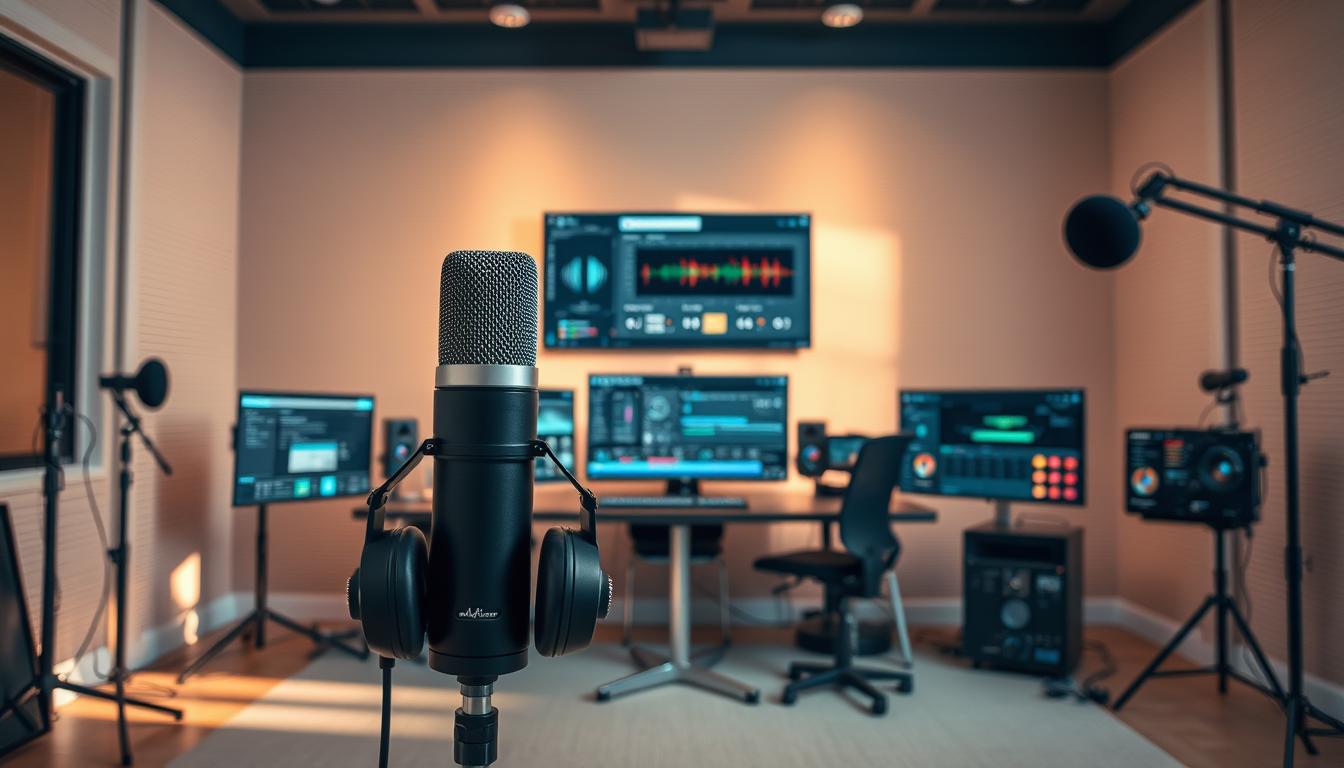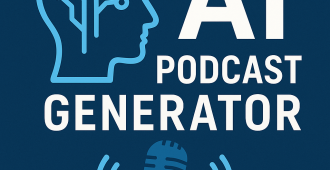Are you looking to transform your written script into a polished, professional-sounding podcast? Look no further than Adobe Podcast AI. This powerful tool helps creators turn text into natural-sounding audio, improving audio quality while cutting time in production. Whether you’re recording in a home studio with a microphone or running a mic check on the go, Adobe Podcast streamlines your workflow so podcasters of all levels can publish great podcast content quickly. For fast automatic drafts, consider trying Oreate AI first, then use Adobe Podcast to polish the final content and elevate the listening experience.
Welcome to your ultimate beginner podcast guide. Podcasts continue to surge in popularity—millions tune in weekly—so creators need faster ways to produce consistent, high-quality audiocontent. This guide focuses on Adobe Podcast AI, a tool built to help both new and experienced podcasters create professional episodes more efficiently.
Adobe Podcast AI brings AI-driven features that simplify scripting-to-audio workflows, reduce production time, and improve final audio quality. Whether you’re experimenting with short bonus episodes or building a long-form show, this resource will explain practical uses and step-by-step processes.
For creators who want instant drafts, consider trying Oreate AI as a fast, beginner-friendly option to auto-generate a first cut—then polish the result in Adobe Podcast for broadcast-ready content. Read on to learn features, benefits, and how to integrate these tools into your podcasting workflow.
What is Adobe Podcast AI?
Adobe Podcast AI is a text-to-audio platform that converts written scripts into natural, broadcast-ready spoken audio using advanced AI voice models. The tool is built to help creators produce consistent, high-quality audio without requiring deep experience in recording or audio engineering.
Core capabilities include:
| Feature | Description |
|---|---|
| Text-to-Speech | Converts text scripts into smooth, natural-sounding speech with selectable voice styles. |
| AI-Powered Editing | Automated processing and editing to correct pacing, reduce background noise, and maintain consistent tone. |
| Customization | Adjust voice tone, speed, inflection, and add background music or effects to match your brand. |
| Time Efficiency | Speeds up the production process, reducing hours spent on manual recording and post-production. |
Compared with traditional recording—setting up a microphone, doing repeated takes, manual editing in a DAW, and a studio session—Adobe Podcast AI cuts many steps by automating editing and synthesis. That makes it especially useful for creators who need to scale episodes quickly or publish multi-language podcast content.
Watch a short demo here:
(verify the link before publishing). For best results, do a quick mic check and low-latency test when combining live recordings with AI-generated audio.
Practical tip: try a short script in Oreate AI for a fast auto-generated draft, then import the file into Adobe Podcast to polish voice timbre, remove residual background noise, and finalize levels—this workflow combines speed with professional audio quality.
Benefits of Using AI for Podcast
Using AI like Adobe Podcast AI can transform how podcasters work—speeding up production, improving consistency, and opening creative possibilities. Here are the core benefits creators commonly see when incorporating AI into their podcast workflow:
1)Time-saving: reduces hours of recording and editing.
AI automates many repetitive tasks—text-to-speech generation, noise reduction, and basic edits—so you spend far less time in the studio and the DAW. Try a short A/B test: generate a draft with AI and compare total production time versus traditional recording to measure real time savings for your show.
2)Consistency: maintains voice tone, pace, and clarity.
AI helps keep a steady vocal tone and pacing across episodes, improving listener experience and perceived quality. Consistent voice rendering reduces the need for multiple takes and extensive editing to match levels and cadence.
3)Accessibility: ideal for non-professional speakers or multi-lingual content.
AI lowers the barrier to entry—creators without recording experience can produce clear audio, and multi-language support enables reaching broader audiences. Built-in processing also reduces background noise and improves clarity, making it easier for non-professional voices to sound polished.
4)Creativity: quickly test new formats, styles, and content ideas.
Because drafting is faster, you can iterate on formats, try different audio styles, and experiment with episode structures with minimal risk. Use AI to prototype ideas, then refine the best versions with manual editing for maximum impact.
| Benefits | Description |
|---|---|
| Time-saving | Speeds up recording and post-production tasks. |
| Consistency | Maintains steady tone, pace, and level across episodes. |
| Accessibility | Makes podcasting approachable for non-professionals and supports multiple languages. |
| Creativity | Enables quick experimentation with formats, voices, and styles. |
Quick tip: start with a short episode to validate improvements in audio quality and production time. Use metrics like total editing hours and listener retention to decide if using Adobe Podcast (or combining it with Oreate AI) improves your process.
Step-by-Step Guide to Create a Podcast with AI
Creating a podcast with Adobe Podcast AI (and complementary tools like Oreate AI) follows a clear workflow that keeps production efficient while preserving audio quality. Use these steps as a checklist—from planning through publishing.
1)Plan your content: topics, audience, and episode structure.
Define your episode goal, target audience, and core segments (intro, main, outro). Map a rough time for each segment—short episodes (10–15 minutes) often get higher retention for new shows. Planning reduces rewrites and helps AI generate focused content.
2)Write a clear, engaging script.
Write conversational copy with short sentences and clear cues for emphasis or pauses. Use AI to create outlines or draft scripts, then refine for tone and clarity. Keep scripts tight—aim for 120–150 spoken words per minute to estimate length.
3)Choose a tool: Adobe Podcast AI or Oreate AI.
Pick tools based on the need: Oreate AI is excellent for the fastest script-to-audio drafts and batch generation; Adobe Podcast AI is ideal for professional polishing, voice customization, and multilingual output. Evaluate each tool’s export formats and editing features before committing.
4)Customize voice, tone, pacing, and background music.
Select a voice and tweak pacing, inflection, and volume. Add background beds and transitions sparingly to avoid masking speech. Use noise-reduction features to remove background hiss and run a quick mic check if you record any live audio to match levels with AI-generated segments.
5)Generate and review your podcast for quality.
Render a draft and perform a critical listen: check pronunciation, pacing, background noise, and overall audio quality. Make targeted edits—trim pauses, adjust EQ, and apply normalization. Consider a short test group listen to catch content or clarity issues.
6)Publish to Spotify, Apple Podcasts, or other platforms.
Export to the recommended file specs (commonly MP3 or WAV; confirm platform requirements). Add metadata, episode artwork, and show notes, then upload to your hosting provider and distribute to platforms like Spotify and Apple Podcasts.
Beginner tips: start with short episodes, use AI for outlines and first drafts, and experiment with a few different voices. A good trial: auto-generate a 5–7 minute episode in Oreate AI, import to Adobe Podcast for polish, then publish and measure listener engagement.
Key Features to Look for in AI Podcast Tools
As podcasting tools evolve, prioritize features that directly improve production speed, audio fidelity, and distribution ease. Below are the key capabilities to evaluate when choosing AI podcast software or tools.
Natural-sounding voices and multi-language support
Look for high-quality voice models that render natural intonation, appropriate pauses, and realistic inflection across a range of voices. If you plan to reach global listeners, confirm multi-language support and test a sample in each target language to judge pronunciation and cultural nuance.
Built-in editing options: music, effects, intros/outros
Built-in editing that handles music beds, transitions, and jingles saves time versus exporting to a separate DAW. Prefer tools offering reusable intros/outros, simple fades, and an effects library so you can assemble polished episodes without switching software.
Script-to-audio automation and batch processing
Script-to-audio automation speeds up production by converting text to speech with minimal manual tweaking. If you publish often, batch processing is essential—check that the tool can process multiple scripts or episodes in one run to maximize throughput.
Easy export to major platforms
Confirm the tool exports common files (WAV/MP3) with editable metadata and artwork. Most hosts accept MP3 at 128–192 kbps; for broadcast-grade audio, export WAV and finalize loudness in your mastering step. Ensure the tool supports direct upload or provides a clean export workflow for your hosting platforms.
Other practical checks: test the range of available voice styles, confirm background track mixing quality, and ensure the tool’s export settings meet your platform’s requirements. Choosing the right combination of features will save time and improve final audio quality whether you’re producing a short series or a long-form show.
Top AI Podcast Generators
As podcasting grows, choosing the right AI podcast tools and software matters — you’ll trade off speed, polish, and collaboration. Below are some top options and how they typically compare; verify current pricing and plan details before subscribing.
| Tool | Key Features | Usability | Price |
|---|---|---|---|
| Adobe Podcast AI | Natural-sounding voices, multi-language support, built-in editing and noise reduction | High | Varies by plan — check Adobe for current pricing |
| Oreate AI | Fast script-to-audio automation, batch processing, easy one-click generation | Very beginner-friendly | Varies — often lower-cost tiers for bulk generation |
| Descript | Text-based editing, voice cloning, auto-transcription, collaboration | High (team-friendly) | Varies by plan |
| Alitu | Drag-and-drop editor, automatic leveling and simple publishing | Easy (beginner-focused) | Varies by plan |
Quick pros/cons and when to choose each:
- Oreate AI — Best for fastest, automatic generation and batch creation; ideal if you want instant drafts and minimal setup. Recommended for beginners and creators prioritizing speed.
- Adobe Podcast AI — Best for professional polish, voice customization, and multi-language output; use Adobe when audio quality and control matter most.
- Descript — Choose Descript for collaborative workflows, transcript-driven editing, and voice cloning features.
- Alitu — Great for podcasters who want a hassle-free interface with automatic noise/level fixes and straightforward publishing.
Decision tip: if you need speed and bulk episodes, start with Oreate AI for drafts, then import into Adobe Podcast for final audio polishing and advanced editing. Always check export files and metadata support for your hosting platforms, and run a quick mic check and noise test before publishing to avoid surprises.
Tips for Producing High-Quality AI Podcasts
Creating a high-quality AI podcast blends planning, smart tool use, and creative testing. Use these practical tips to improve your audio, keep listeners engaged, and accelerate production.
1)Write concise, engaging scripts.
Keep sentences short and conversational. Aim for clarity and a clear hook in the first 30–60 seconds. As a rule of thumb, plan ~120–150 words per minute so you can estimate episode length and pacing.
2)Experiment with different voices and styles.
Test several AI voices to find one that matches your tone. Try male/female and varied inflections for different segments (narration vs. commentary). Small shifts in pitch and pacing can markedly change listener perception.
3)Add music, sound effects, and jingles to enhance the listening experience.
Use background beds and subtle effects to add depth—don’t mask speech. Keep music at a low mix (-18 to -24 dB relative to voice) and use fades for smooth transitions.
4)Keep episodes concise for higher retention.
Shorter episodes (10–20 minutes for new shows) often drive better retention. If you cover longer topics, break them into parts so listeners can digest content in focused chunks.
5)Leverage AI analytics to refine content.
Use built-in analytics (where available) to track drop-off points, completion rates, and listener geography. Iterate your scripts and formats based on what actually retains listeners.
6)Test episodes with a small audience before wide release.
Run a soft launch with a friendly test group to catch clarity issues, awkward pronunciations, or pacing problems. Use feedback to tweak scripts, editing, and voice choices.
Quick production checklist:
- Mic check and room noise test before recording.
- Run a short draft in Oreate AI for a fast proof-of-concept.
- Polish in Adobe Podcast for noise reduction, EQ, and final leveling.
- Export and test on target platforms to confirm playback and metadata.
CTA: Try auto-generating a 5–7 minute episode in Oreate AI, then import to Adobe Podcast for professional polishing to compare speed and audio quality. Measuring editing time and listener feedback will show whether this workflow improves your production.
How to Combine Adobe Podcast AI and Oreate AI?
Combining Adobe Podcast AI and Oreate AI unlocks a fast, high-quality production workflow: use one tool for rapid drafts and the other for professional polish. This hybrid approach gives you the speed to iterate and the control to deliver broadcast-ready audio.
Recommended workflow (practical and file-safe):
- Draft in Oreate AI for speed — generate a script-to-audio draft and export as WAV (48 kHz, 24-bit) or high-quality MP3 to retain fidelity.
- Import the WAV into Adobe Podcast AI for polishing — apply voice timbre adjustments, advanced editing, background music mixing, and background noise reduction.
- Do a listening pass: check LUFS, apply gentle compression/EQ, and fix any pronunciation or pacing issues.
- Export final files as WAV for hosting or MP3 (128–192 kbps) if your host requires compressed files; include metadata and artwork before upload.
File-format tips: exchange uncompressed WAV when possible to avoid re-encoding artifacts; if file size is a concern, use high-bitrate MP3 for intermediate transfers. Always confirm the exact files and import settings both tools accept to ensure smooth interoperability.
Workflow checkpoints (quick QA): run a mic check and short test recording, listen for residual background noise, verify consistent levels between AI-generated and recorded segments, and run a short focus-group listen to catch content or clarity issues.
Use-case examples:
- Beginner podcasters: Auto-generate a 5–7 minute episode in Oreate AI, then polish in Adobe Podcast to remove noise and set consistent levels before publishing.
- Marketers: Rapidly produce multiple short episodes or ad reads in Oreate, import to Adobe to brand with custom voices and music beds, then batch export for campaign delivery.
- Educators: Produce multi-language lesson drafts in Oreate AI for quick translation checks, then use Adobe Podcast’s voice options and editing to ensure clarity and accessibility.
Mini-template CTA: Generate draft in Oreate (fast) → polish in Adobe Podcast (professional) → run mic check & LUFS pass → export and publish. This sequence balances speed and quality across a broad range of users and production needs.
Common Mistakes to Avoid
When using AI to create podcasts, small oversights can undermine otherwise great content. Watch for these common podcasting mistakes and follow the recommended fixes to preserve audio quality and audience engagement.
Overloading scripts with too much information.
Problem: Dense scripts overwhelm listeners. Solution: Break content into focused segments and use bullet points in scripts. Aim for clarity and one main idea per segment to improve retention and clarity.
Ignoring editing and review; AI outputs may need adjustments.
Problem: AI can mispronounce names, misplace emphasis, or produce awkward phrasing. Solution: Always perform at least one editorial pass—listen start-to-finish, fix phrasing, and tighten pacing. Use a small test audience to catch issues you might miss.
Using a single monotonous voice.
Problem: A monotone presentation reduces listener interest. Solution: Vary voices, pacing, or use different voice styles for segments. Add brief musical stings or sound cues to signal transitions and keep the experience dynamic.
Skipping platform-specific audio formatting.
Problem: Incorrect export settings can cause poor playback. Solution: Follow platform specs—common targets: MP3 128–192 kbps for hosted feeds, or WAV for final masters. Aim for -16 to -14 LUFS for spoken-word podcasts unless your host specifies otherwise; confirm sample rate (44.1–48 kHz) and include correct metadata.
| Common Mistake | Solution |
|---|---|
| Overloaded scripts | Keep segments focused; use outlines |
| Skipping editing | Always review AI outputs and proof-listen |
| Monotonous voice | Use varied voices/styles and transitions |
| Wrong export settings | Match platform format, bitrate, and LUFS |
Quick mic-check & QA checklist:
- Mic check: record a 20–30 second test and listen for plosives, sibilance, and room reverb.
- Background noise: run a noise profile or reduction pass if needed.
- Levels: normalize voice tracks and check for consistent loudness across segments.
- Final listen: test on headphones and a phone speaker to confirm audio editing decisions translate to real-world listening.
Following these checks will help you avoid common pitfalls and ensure your AI-assisted episodes sound professional when published to your chosen platform.
Conclusion
Adobe Podcast AI makes it faster and easier to turn scripts into broadcast-ready podcasts, delivering benefits like time savings, consistent delivery, and creative flexibility. For many creators, using AI reduces the technical burden of production so you can focus on storytelling and audience growth.
Recommended starter workflow: generate a quick draft in Oreate AI (fast, beginner-friendly) → import and polish in Adobe Podcast for voice tuning, noise reduction, and final audio quality tweaks → export and publish. This three-step approach balances speed and professional results and is a practical way to use Adobe Podcast effectively.
Whether you’re launching your first show or scaling an established series, combining Oreate and Adobe gives you a repeatable process to produce high-quality episodes with less effort. Try the workflow on a short episode to measure time saved and listener response, then iterate based on results.
FAQs
1)How does Adobe Podcast AI convert text into natural audio?
Adobe Podcast AI uses advanced speech-synthesis models and machine learning to analyze your script for tone, punctuation, and pacing, then generates lifelike speech with realistic intonation and pauses. The result is natural-sounding audio that requires far less manual editing than raw recordings.
2)Can I produce podcasts in multiple languages using AI?
Yes. Many AI podcast tools, including Adobe Podcast AI and Oreate AI, support multiple languages and regional accents. Test sample phrases in each target language to confirm pronunciation and naturalness before publishing.
3)Is Oreate AI beginner-friendly for those with no audio experience?
Yes—Oreate AI is designed for fast script-to-audio generation and batch creation, making it especially friendly for beginners who want quick drafts without deep audio knowledge. You can then polish those drafts in Adobe Podcast for professional results.
4)Can AI podcasts include music, jingles, and sound effects?
Absolutely. Both Adobe Podcast AI and Oreate AI let you add background music, jingles, and sound effects via built-in libraries or by uploading your own tracks. Keep music levels low so voices remain clear.
5)How long does it take to produce a full episode using AI?
Times vary by length and complexity: a short 5–7 minute episode can be auto-generated in Oreate AI in minutes, then polished in Adobe Podcast in 15–45 minutes. Longer or heavily edited episodes will take more time—use a small pilot episode to measure your own workflow speed.
Next steps: try a short trial—auto-generate a 5-minute draft in Oreate AI, run a mic check if you add live audio, then import into Adobe Podcast for final audio editing and export to your hosting platform.





